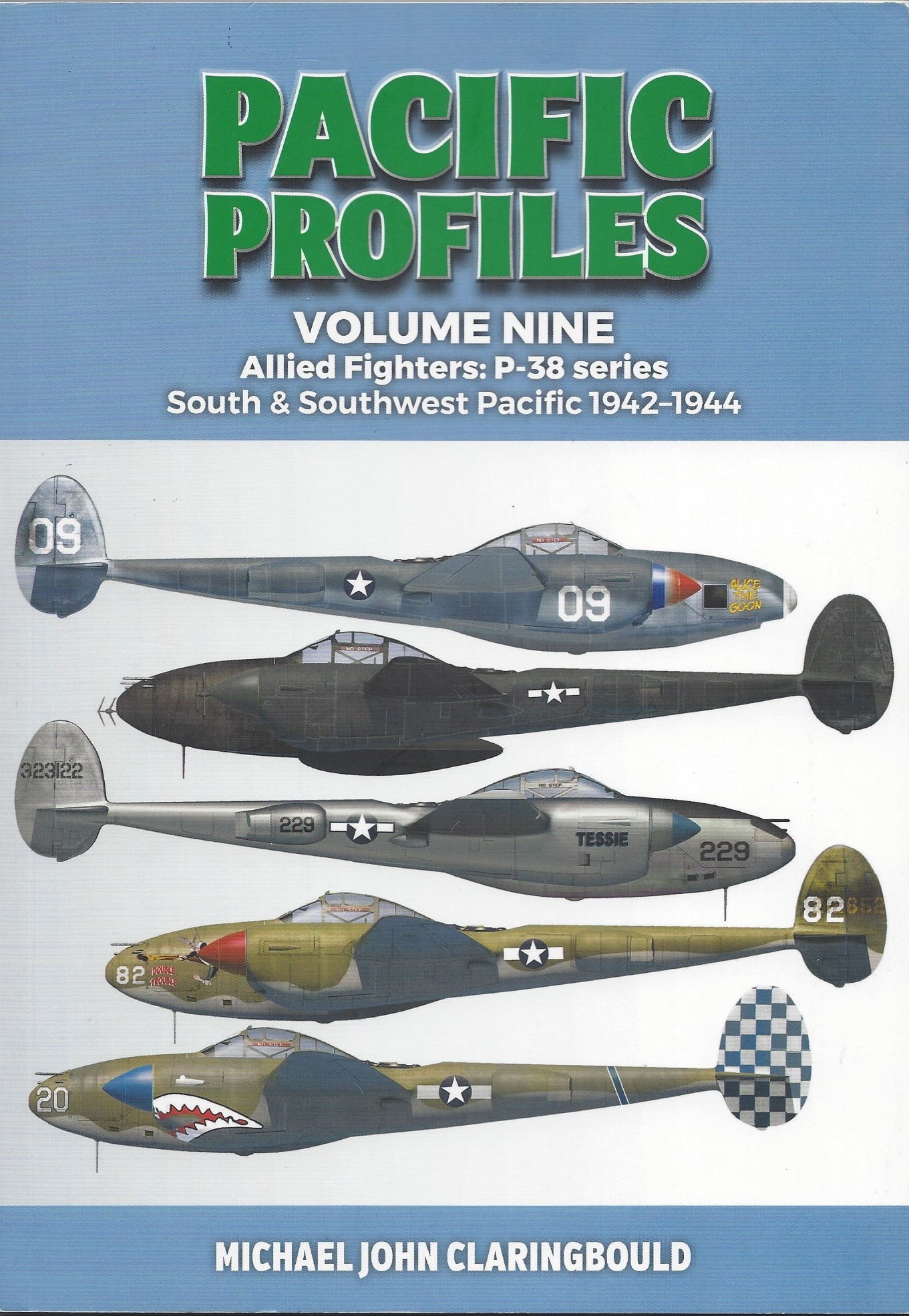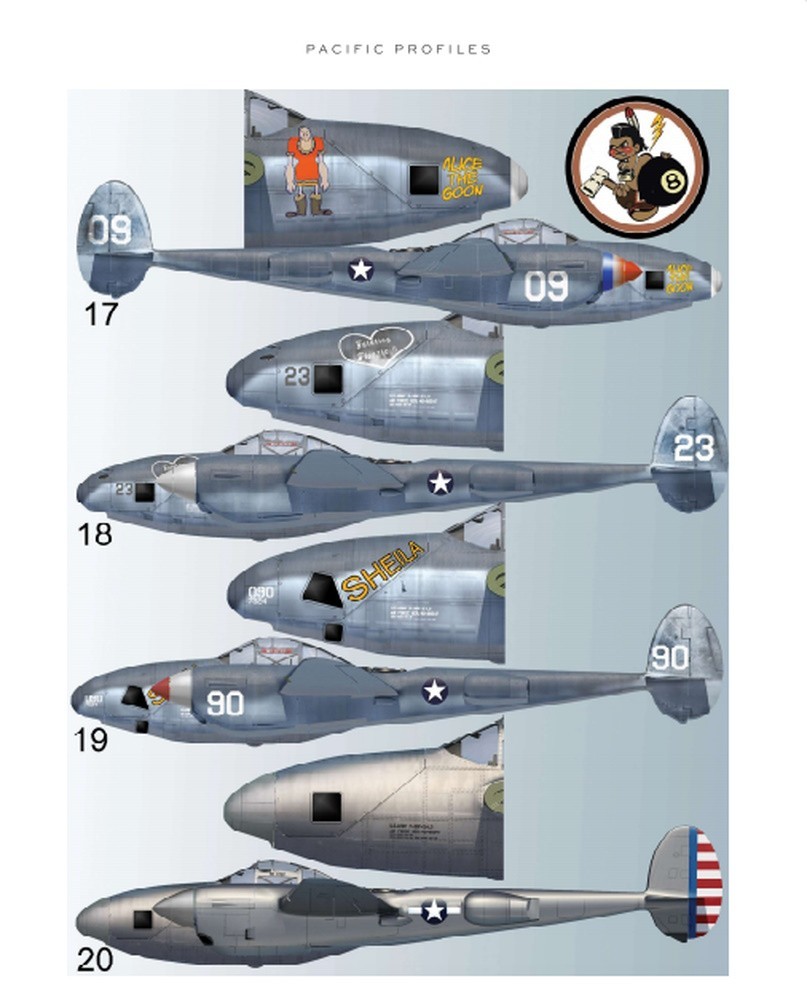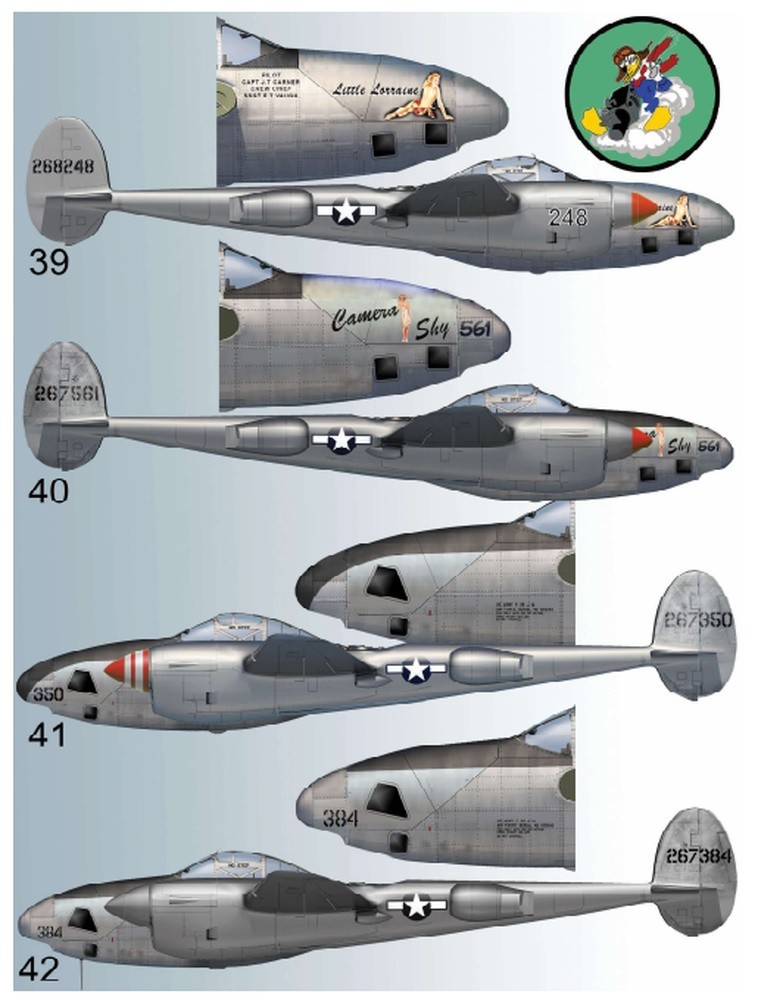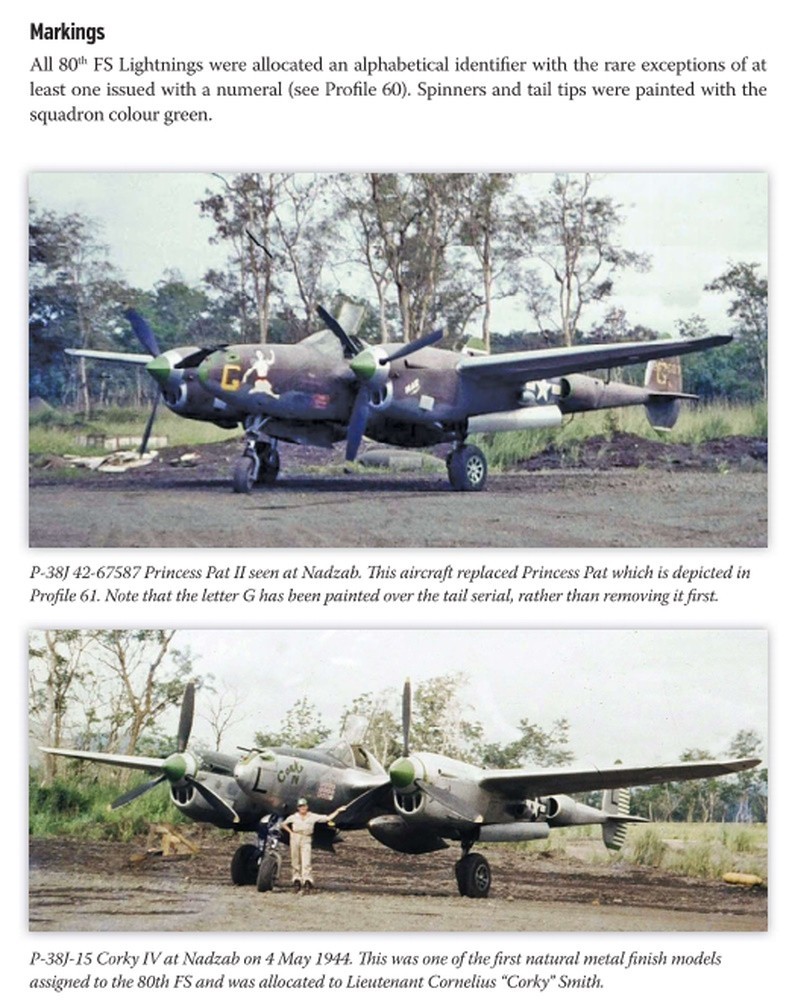
Introduction
When the Lockheed P-38 Lightning became operational in New Guinea in late 1942, the Allied air forces finally had a fighter that could face the vaunted Mitsubishi Zero with an edge in performance. P-38 operations over New Guinea, Guadalcanal and the rest of the Solomon Islands helped blunt Japanese air attacks and start the long road towards Rabaul, Japan’s main base for their Southern Seas Area. This book relates how essential and active they were in the South Pacific. It also presents the P-38 squadrons’ known losses compared to victory claims, challenging the Lightning’s legend. Legends and myths and misunderstandings have been perpetuated for decades. Fortunately, survivors of the era have emerged with a growing amount of surviving original documents and relics. An increasing cadre of modelers and researchers privy to such resources, capable of reading and understanding them, and dedicated to analyzing actual colors and markings, are establishing a more homogeneous consensus of the subject. This new book corrects the record and includes new markings and information.
Pacific Profiles Volume Nine Allied Fighters: P-38 series South & Southwest Pacific 1942-1944 is a new title from Avonmore Books, which specializes in high-quality printing of titles focusing on the early part of the air war in the southwest Pacific. Authored and illustrated by Japanese wartime aviation expert and former diplomat Michael John Claringbould, this book is the fruit of months burrowing into original American and Japanese records and other documents. Raised in Port Moresby, Papua New Guinea, these subjects are a life-long pursuit of his. Composed of 124 pages including the index, it is published by Avonmore Books and catalogued with ISBN 9780645246971. Avonmore tells us:
The Pacific Profiles series presents the most accurate WWII profiles of aircraft which served throughout the South Pacific. Volume Nine covers the P-38 and variants including the photo-reconnaissance F-4 and F-5, along with field-modified P-38G night-fighters. The P-38 flew combat in the SWPA and SOPAC theatres until mid-1944, serving a total of nineteen Fifth and Thirteenth Air Force USAAF combat squadrons, one service squadron, Fifth Fighter Command, and finally with the Combat Replacement Training Center at Nadzab.
Most profiles are presented for the first time, alongside an explanation of markings, including squadron heraldry and squadron codes. Until now there has been a paucity of accurate information about some markings, especially those which attend the Thirteenth Air Force, night-fighter and photo-reconnaissance units.
Each profile has been produced by citing wide-ranging reference material, including official squadron records, colour movies, maintenance logs, diaries, wreck site inspections and thousands of photos including colour slides. A brief summary history of each unit and the rationale of its markings completes the text.
The author, Michael Claringbould, is world-renown for his expertise on the Pacific air war. Never before have Pacific P-38s and their colourful derivatives been illustrated with such accuracy and detail.
The seeds for Mr. Claringbould’s passion were planted in 1976 when, "...an irritable priest at Alexishafen, on New Guinea's north coast, reluctantly allowed me to scour and photograph Japanese aircraft wrecks on the mission's land," where he found a Ki-43-II. "Curiosity caused me to start collecting all material on this arcane subject, but it was frustrating. Few publications, including Japanese-language ones, agreed on interpretations..." Thus he began decades of research to learn and clarify.
Mr. Claringbould has authored more than 20 other titles. Most concern the air war in the South Pacific. His series Pacific Profiles currently offers 10 titles, focusing on Allied and Japanese fighters, bombers, transports and miscellaneous types, and Japanese seaplanes. You can view this book on the company website here: Pacific Profiles Volume Nine Allied Fighters: P-38 series South & Southwest Pacific 1942-1944.
The mount of America’s top two aces, it is hard not to appreciate the P-38 and I am enthusiastic to show you what this book reveals.
Pacific Profiles Volume Nine Allied Fighters: P-38 Series is told through 23 chapters along with front and back content:

These chapters are richly illustrated with photographs and artwork. After a brief introduction to the author, the book presents the problems with getting P-38s into combat, and challenges the operational and combat histories of the P-38. Glossary & Abbreviations presents common terms and usage, i.e., FS = Fighter Squadron, NFS = Night Fighter Squadron, PRS = Photographic Reconnaissance Sqdn. In P-38 Markings we are immersed into the subject of tactical and technical markings, some of which caused me to think how did I miss some of those markings over the decades?'. These include sub-contractor or sub-assembly codes, and construction, manufacturer and production line serial numbers applied to the nose exclusive of the well known USAAF serial number ubiquitous on American empennages.
Chapters 2-23 introduces us to the air units. Pacific Profiles are a wealth of information and each chapter begins with a history of the unit including:
· Commanding officers
· Establishment location and training areas if pertinent
· Base of arrival/operations in-theater
· Aircraft unit codes
· Aircraft manufacturer numbers
· Date of commencement of operations
· Combat
· Losses
· Transfers
· Re-equipping
When available, each unit history includes the record of losses of pilots and aircraft (with name and cause when known):
- 12th FS's first loss was a Lt Whitaker in a P-38G while escorting a reconnaissance flight over Bougainville on 29 April 1943.
- 421st NFS departed for the combat zone aboard USAT Sea Pike from San Fransisco on 4 December 1943, but did not receive aircraft for more than a month after arrival in-theater, and those were hand-me-down P-38Fs from the 9th FS.
The author may note kills awarded during a fight but will compare those to pilot claims and known Japanese losses, i.e., 339th Lt Murray Shubin's "ace-in-a-day" dogfight over Guadalcanal in June, 1943. Personal interest stories are included such as Major Peyton Mathis was the first pilot to fly a P-38 non-stop from England to North Africa.
Each chapter continues with a treatise on the markings and colors of the aircraft. Particular squadron aircraft examples are presented with photographs and usually reproduced as artwork, as are tactical markings such as command stripes. Most squadrons are presented through 3-5 pages of text and photos, with 4-19 illustrations.
Full color profiles with accompanying captions and commentaries round out each chapter. Anecdotes and information enrich many histories, some fascinating yet many poignant, i.e., Lt Keown was lost during "Black Sunday," bailing out but perishing, his body recovered and buried by natives, the aircraft found in 2005. LTC Tommy Lynch's P-38 was discovered, and the author photographed it in 2020; his wingman for the mission, future ace-of-aces Richard Bong, returned home with a dead engine and scores of bullet holes in his P-38.
For a book this size, it is a wealth of information.
Photographs, Artwork, and Graphics
If you have looked at other Pacific Profile books you know they feature an impressive gallery of black-and-white and even color photos to support the text. They span the gamut of professionally exposed and developed images to amateur pictures. Some are stills taken from motion pictures. Many show damaged aircraft. The author chose excellent images that visually confirm insignias and odd camouflage patterns. I have been in awe of many of the images.
Perhaps the most impressive part of the book is the original color artwork by the author of select aircraft. The publisher writes:
Each profile has been produced by citing wide-ranging reference material, including official squadron records, colour movies, maintenance logs, diaries, wreck site inspections and thousands of photos including colour slides.
As in the artist’s other books, weathering and wear is illustrated. His experience as a pilot allows him to capture the atmospherics of the in-flight illustrations. The author-artist also recreates the special hazy blue camouflage for reconnaissance aircraft. Many profiles are authenticated with a wartime photograph of the aircraft.
Twenty-two chapters of squadron histories begin with 8th PRS and 17th Provisional Squadron. Each squadron history features a brief history of the unit including as many of the following as known:
- Date of formation
- Commanding officers
- Training areas if pertinent
- Squadron nickname
- Base of arrival in-theater
- Markings
- Aircraft manufacturer numbers
- Date of commencement of operations
- Combat
- Losses
- Transfers
- Reequipping
Most of the profiles include a a line or two of narrative of the history of the aircraft, some consist of a small paragraph. Many illustrations are accompanied by photographs of the subject aircraft.
Artwork
While the academic and technical research is the brain of this book, perhaps the most impressive part is the original color artwork that visually spotlights what the text imparts. The author richly illustrates select Lightnings – 100 profiles - with over 122 supporting illustrations. If the Lightning had unique markings, they are reproduced in a separate image and the same is true of the center cockpit/weapons bay nacelle as it is hidden behind the outer engine nacelles. Many profiles are authenticated with a wartime photograph of the aircraft. A sampling are P-38s painted with:
- Hazy blue camouflage
- Overall dark blue (confirmed with an incredible color photo)
- Olive drab and black night-fighter
- Checkertails
- Overall yellow.
The following is the breakdown of illustrations per section and unit.
P-38 Markings: two noses; six tails; manufacturer serial block.
8th PRS and 17th Squadron (Provisional): four profiles of P-38s and four of central nacelles.
39th FS: 10 profiles with 11 close-ups of the central nacelle and nose art, including unit insignia.
6th NFS (Detachments A & B): two profiles and two central nacelles.
8th PRS: four profiles and five close-ups of nacelles and insignia.
12th FS: six profiles and seven close-ups of nacelles and insignia.
17th PRS: two profiles with three close-ups of nacelles and insignia.
25th PRS: four profiles with five close-ups of nacelles and insignia.
9th FS: six profiles with nine close-ups of nacelles and insignia.
26th PRS: four profiles with five close-ups of nacelles and insignia.
35th FS: four profiles with seven close-ups of nacelles and insignia.
36th FS: four profiles with eight close-ups of nacelles and insignia.
44th FS: eight profiles with 11 close-ups of nacelles and insignia.
80th FS: eight profiles with 11 close-ups of nacelles and insignia.
339th FS: four profiles with six close-ups of nacelles and insignia.
418th NFS: two profiles with two close-ups of a nacelle and insignia.
419th NFS: two profiles with three close-ups of nacelles and insignia.
421st NFS: two profiles with two close-ups of a nacelle and insignia.
431st FS: six profiles with seven close-ups of nacelles and insignia.
432nd FS: six profiles with six close-ups of nacelles and insignia.
433rd FS: six profiles with six close-ups of nacelles and insignia.
Fifth Fighter Command HQ: four-each profiles and nacelles.
Unique Lightnings: four profiles, three close-ups.
Action art: P-38H patrolling Santa Isabelle.
Action art: field-modified night-fighter climbing out.
Action art: after head-on pass with a Zero.
Map: P-38 airfields, 13th Air Force, SOPAC 1942-44.
Map: P-38 airfields, 5th Air Force, SWPA 1942-45.
Aside from the airplanes, modelers will find a wealth of source material for airfield paraphernalia to create and detail dioramas.



Conclusion
Pacific Profiles Volume Nine Allied Fighters: P-38 series South & Southwest Pacific 1942-1944 for my money is yet another incredible title from Avonmore Books. Valuable as the erudite text is, this book would be worth shelf space just for the gallery of photographs and illustrations. Modelers should be inspired to build a Lightning with uncommon and unique camouflage and markings, and plenty of photos to inspire detailing and dioramas.
This book is an amazing resource for modelers seeking P-38 colors and markings. I am thrilled that the author created a Pacific Profiles volume for the P-38 - especially because it includes the 13th Air Force Lightnings - and enthusiastically recommend it. Now to start some P-38 models!
Please remember to mention to Avonmore Books and retailers that you saw this product here – on Aeroscale.



























